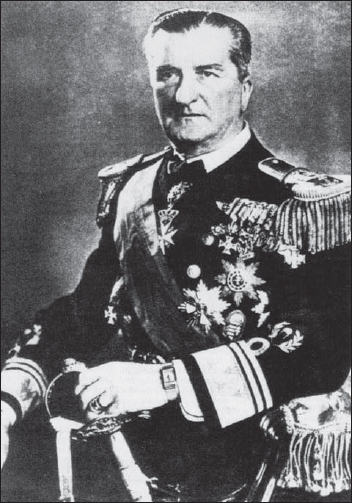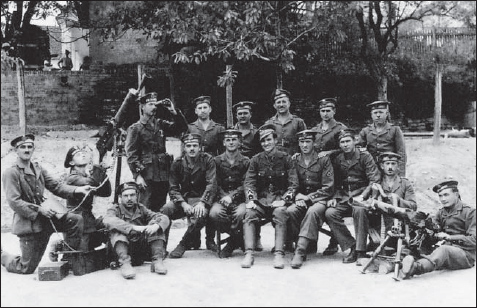

THE HISTORICAL CONTEXT
THE ROYAL HUNGARIAN ARMY
RECOVERING THE LOST TERRITORIES
THE INVASION OF THE USSR
OCCUPATION FORCES
DEFENDING EASTERN HUNGARY
THE FINAL MONTHS
PLATE COMMENTARIES
The Austro-Hungarian Empire was established in April 1867 with the Habsburg Franz-Josef as Emperor and King of Hungary. On 5 December 1868 the Magyar Királyi (M. Kir.) Honvédség, the Royal Hungarian Army (literally ‘Defence Force’) was established.
In 1914 Hungary comprised 109,218 square miles (282,876 sq/km) with 20.8 million inhabitants – 55 per cent Magyars and Székelys (a Hungarian-speaking people of uncertain origin), 45 per cent Romanian, German, Croat, Serb, Slovak, Ruthene, Jewish, Roma, Slovene and Italian. During World War I Hungarians fought in the Austro-Hungarian Common Army and Royal Hungarian Army against the Entente nations.

Vice-Admiral Miklós Horthy (1868–1957). A Protestant landowner and the Austro-Hungarian Fleet’s last commander, Horthy earned great prestige by re-establishing the Hungarian Kingdom; but by June 1941 this indecisive anglophile had allowed pro-German advisers to persuade him to commit Hungary to the disastrous Axis alliance. (Friedrich Herrmann Memorial Collection)
On 3 November 1918 Austro-Hungary, hard-pressed but undefeated, signed an armistice anticipating a formal peace treaty. The Common and Royal Hungarian Armies were abolished; and from November 1918 the Entente demanded that Hungary immediately cede Slovakia to Czechoslovakia, Transylvania to Romania and Croatia, and the Bácska-Baranya districts to the Kingdom of the Serbs, Croats and Slovenes (SHS – later, Yugoslavia). Some 70,000 Czechoslovak, Serbian and Romanian forces occupied these areas before advancing further into Hungary. On 23 March 1919 a Hungarian Soviet Republic was proclaimed, and the 25,000-strong Hungarian Red Army, under experienced former Austro-Hungarian General Staff officers, fought valiantly; but on 1 August the Republican government resigned, and on 4 August the Romanian Army occupied Budapest.
An anti-communist government operated in Arad, later Szeged, southern Hungary, 5 May–9 August 1919, with Vice-Admiral Miklós Horthy de Nagybánya, the last commander of the Austro-Hungarian Fleet, as minister of war. On 9 August, Horthy united various military units into a 25,000-strong National Army (Nemzeti Hadsereg) at Szeged, and by 16 November 1919 he controlled Hungary. Horthy ruled as Regent from 1 March 1920, but in 1921 prevented Károly IV, the former Austro-Hungarian Emperor and King of Hungary, from regaining the throne.

A member of the Parliamentary Guard, wearing the scarlet palace ceremonial uniform with white braids, and white metal helmet with brass edgings. (Tibor Horváth, RegMilHun Collection)
On 4 June 1920 Hungary signed the Treaty of Trianon. The national territory was reduced by 67 per cent to 35,918 square miles (93,030 sq/km); the other regions, with significant Magyar populations, were awarded thus: Slovakia and Ruthenia (600,000 Magyars) to Czechoslovakia; Transylvania (1.7 million Magyars and Székelys) to Romania; Bácska, Baranya and western Bánát (now Vojvodina), Croatia, Medjimurje, Prekmurje (314,000 Magyars) to SHS; Burgenland (26,000 Magyars) to Austria; parts of Árva and Szepes counties to Poland; and Fiume (now Rijeka) to Italy. Hungary’s population of 7,987,000 – 39 per cent of the 1914 total – was 90 per cent Magyar and 7 per cent ethnic German, but 2,640,000 Magyars and Székelys lived in neighbouring states.
The Royal Hungarian Army was reduced to 35,000 volunteers, mainly infantry and cavalry, without reserves. Light weapons were permitted, but no heavy artillery, tanks or aircraft. The Military Inter-Allied Commission of Control, with 52 Entente officers, monitored compliance.
Hungarians universally regarded Trianon as unjust and excessively punitive, dealing a blow to national pride from which Hungary has still not fully recovered. A powerful thousand-year old kingdom was reduced to a weak rump state, vulnerable to attacks from neighbours it had once dominated. Hungary became a landlocked ‘Ruritania’, a kingless kingdom under an admiral with no navy, defended by 9 brigades confronting 60 Czechoslovak, Romanian and Yugoslav divisions. Territorial revisionism – the return of regions taken by Trianon – was a universally popular cause, focusing Hungary’s foreign policy and driving her to seek allies. Under the Rome Protocols of 17 March 1934, Fascist Italy backed Hungary’s claims if Hungary supported Italy’s ally, Austria, against Nazi Germany. When Germany and Italy became allies on 15 October 1936, Hitler supported Hungarian territorial revisionism, but encouraged hostility between Hungary, Romania and Slovakia, only allowing Hungary to regain regions with majority Magyar populations.
The National Army was redesignated the Royal Hungarian Army on 1 Jan 1922 (it was again renamed on 20 Oct 1944, simply as ‘the Army’ – Honvédség – by Ferenc Szálasi). Troops hid from Military Mission inspectors, transferred to the Royal Gendarmerie, civilian police, Customs Guards (from 1925, Border Guards), Finance Guards and the Levente youth organization, or joined cover organizations – the River Guard (Danube Flotilla), Air Office (Air Force), and Police Recruit School (Armoured Troops). These personnel suffered low morale, undertaking non-military duties with civil titles and uniforms, with military officials in plain clothes.

An officer wearing the M1920 service tunic, with captain’s collar patch rank insignia on the stand-and-fall collar, and displaying World War I medal ribbons. (Tibor Horváth, RegMilHun Collection)
On 11 May 1922, 7 mixed brigades (1–7), 2 cavalry brigades (1, 2), 1 named horse artillery (1) and 3 named engineer (1–3) battalions were formed. One mixed brigade (Vegyesdandár), a skeleton corps, manned each military district (I–VII) with 2 named infantry regiments (1–14), single named bicycle and artillery battalions, and hussar (cavalry), signals, supply and motor transport companies. A cavalry brigade had two named cavalry regiments (1–4). The Allied Mission was withdrawn on 31 March 1927, and the Army discreetly updated its weaponry.
On 5 March 1938 Prime Minister Kálmán Darányi announced the Györ Programme of rearmament, under which the armed forces established a five-year expansion plan with ‘Huba I–III’ revised orders of battle, commencing 1 Oct 1938. National conscription was introduced in 1939.
At age 21 (later 19), young men undertook three years’ military service, before transferring to the 1st, 2nd and 3rd Reserves until age 65 or even 70. Potential career non-commissioned officers progressed through junior NCO (officially ‘senior private’, to circumvent Trianon limits) and warrant officer ranks, reaching Alhadnagy only after 29 years’ service. From March 1944, ‘commissioned warrant officers’ were introduced, and a few WOs were promoted Zászlóshelyettes (acting ensign) before the scheme was abandoned on 30 Oct 1944.
From age 10 boys planning an officer’s career attended a military secondary school to graduate as ensigns, or a civilian secondary school and then a military academy for a 4-year (in wartime 3 or 2 years) officers’ course – at Ludovika for combat branches including Royal Gendarmerie; Bolyai for artillery, engineers, signals and River Forces; and Horthy for Air Force. A cadet (Akadémikus) graduated as second lieutenant. Promising lieutenants attended the War Academy or the Technical University of Budapest before becoming general staff or technical artillery staff captains. A high school graduate accepted as a reserve officer candidate was appointed ‘volunteer private’ (Karpaszományos Honvéd), after 2 months lance-corporal, after 5 months corporal and after 12 months cadet warrant officer (Hadpród örmester) and later reserve ensign (Tartalékos zászlós), with promotion to reserve captain possible. Well-connected and well-educated individuals also entered as volunteers, a practice abolished by the Szálasi government. Ethnic Germans were over-represented in the officer corps, many learning Hungarian and adopting Hungarian names in the 1930s to safeguard their careers.

River Forces personnel pose in their khaki field uniforms, with Schwarzlose machine guns. The warrant officer (seated centre) wears the officers’ peaked cap and tunic, the junior NCOs and seamen peakless seamen’s caps and enlisted tunics. They all display dark blue cloth cuff patches with Army-style piping and rank insignia, as worn 1925–40; and note the reenlisted NCO sleeve triangle worn by the leading seaman to the right of the warrant officer. On 1 July 1944 most personnel adopted Army ranks. (Tibor Horváth, RegMilHun Collection)
The rank of colonel-general (Vezérezredes) was reintroduced on 29 July 1941 to replace general, giving Hungarian commanders equivalent status to their German counterparts. Field-marshal (Tábornagy) was a wartime rank for successful field commanders, but none were promoted during World War II.
Horthy, and from 4 Nov 1944 Ferenc Szálasi, was Supreme Commander (Legfelsöbb Hadúr). The defence minister (Honvédelmi minister), an inactive general officer, controlled the Army under the commander-in-chief, replaced from 1 March 1940 by the chief of general staff, reporting directly to Horthy. Wartime chiefs of staff were: 29 Sept 1938 Gen/ColGen Henrik Werth; 6 Sept 1941 ColGen Ferenc Szombathelyi; 19 Apr 1944 ColGen János Vörös; and 16 Oct 1944–9 May 1945 ColGen Károly Beregfy. General staff officers were officially reappointed from 1930 and technical artillery staff officers from 1931. There were three ceremonial guards: the Crown Guard (for the Holy Crown of St Stephen, representing the monarchy), Parliamentary Guard and Regent’s Bodyguard.
Hungary formed three field armies (1st–3rd) on 1 March 1940. Each army (Hadsereg) was commanded by a general or colonel-general, each with three corps; a separate Carpathian Group was also formed. There were 12 corps, each corps (Hadtest) under a lieutenant-general. Seven corps and corps districts (I–VII) were formed on 1 Oct 1938 from the mixed brigades, VIII in Carpatho-Ukraine 15 Sept 1939, and IX in northern Transylvania 4 Sept 1940. A corps comprised HQ battalions and 3 brigades. The Mobile Corps (Gyorshadtest) was formed 1 March 1940 with 2 cavalry and 2 motorized brigades; the AA Corps in spring 1941; and Hungarian Occupation Group (Magyar Megszállo Csoport) on 6 Oct 1941.
Of the 45 brigades raised, 27 were infantry: 1–24 formed 23 Jan 1939, and 25–27 on 15 Sept 1940; 3 Bde was disbanded 1 Aug 1941, and 5 brigades (2, 5, 8, 21 & 24) transferred to HOG on 1 Oct 1941 as 102–124 Brigades. A 9,500-man brigade (dandár), under a major-general, had HQ companies, supply services, 1× 2-battalion field artillery regiment (7 batteries), and 2 infantry regiments. An infantry regiment (ezred)(zászlóalj)(század)(szakasz),(raj)